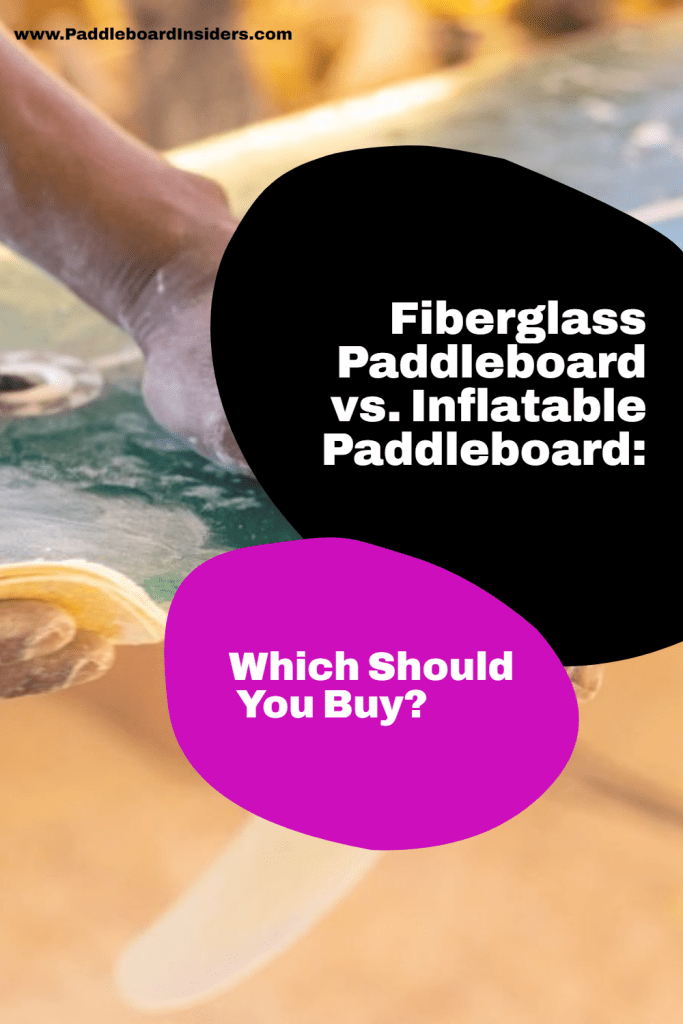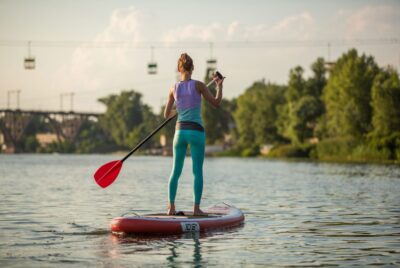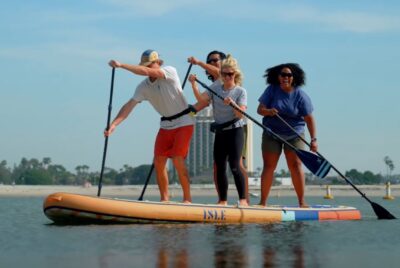Fiberglass Paddleboard vs. Inflatable Paddleboard: Which Should You Buy?
*We may earn a commission for purchases made using our links. Please see our disclosure to learn more.
“Fiberglass paddleboard or Inflatable paddleboard?” This is such a common question that people have when they are first entering the world of paddleboarding.
Both options have their own set of advantages and disadvantages, and the decision ultimately depends on your preferences, intended usage, and specific requirements.
In this article, I will provide you with a comprehensive comparison of fiberglass paddleboards and inflatable paddleboards, along with recommendations to help you make an informed decision on which you should buy.
| Looking for our best paddle board product recommendations? Check the Paddleboard Insiders Buyer Guides |
Table Of Contents
- Understanding A Fiberglass Paddleboard
- Understanding An Inflatable Paddleboard
- Other Factors To Consider When Comparing A Fiberglass Paddleboard To An Inflatable One
- Usage and Portability:
- Stability and Performance:
- Durability and Maintenance:
- Based on different scenarios, here are some recommendations:
- Scenario 1: Casual Paddling and Occasional Travel:
- Scenario 2: Performance-Oriented Paddling and Frequent Travel:
- Scenario 3: Family-Friendly and Versatile Paddleboarding:
- My Favorite Inflatable SUPs Of 2024:
- Conclusion
- FAQs
Understanding A Fiberglass Paddleboard
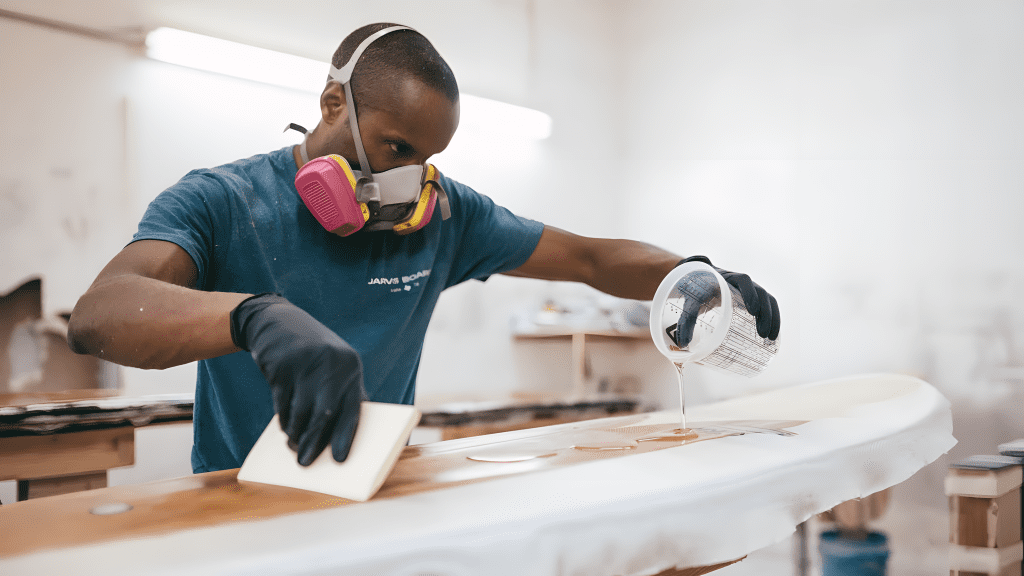
Fiberglass paddleboards, also known as hardboards, are crafted from a rigid foam core wrapped in multiple layers of fiberglass. These boards offer excellent performance and are favored by professional paddlers and enthusiasts.
Their Construction:
The construction of a fiberglass paddleboard is actually really interesting. They follow similar principles around how surfboards are created.
They have a EPS foam core in the center which is surrounded by around 5 different layers of fiberglass. This forms the basis of the board and then you have the aesthetic elements like graphics or a wood veneer, and finally a clear epoxy coat and a deck pad to finish it.
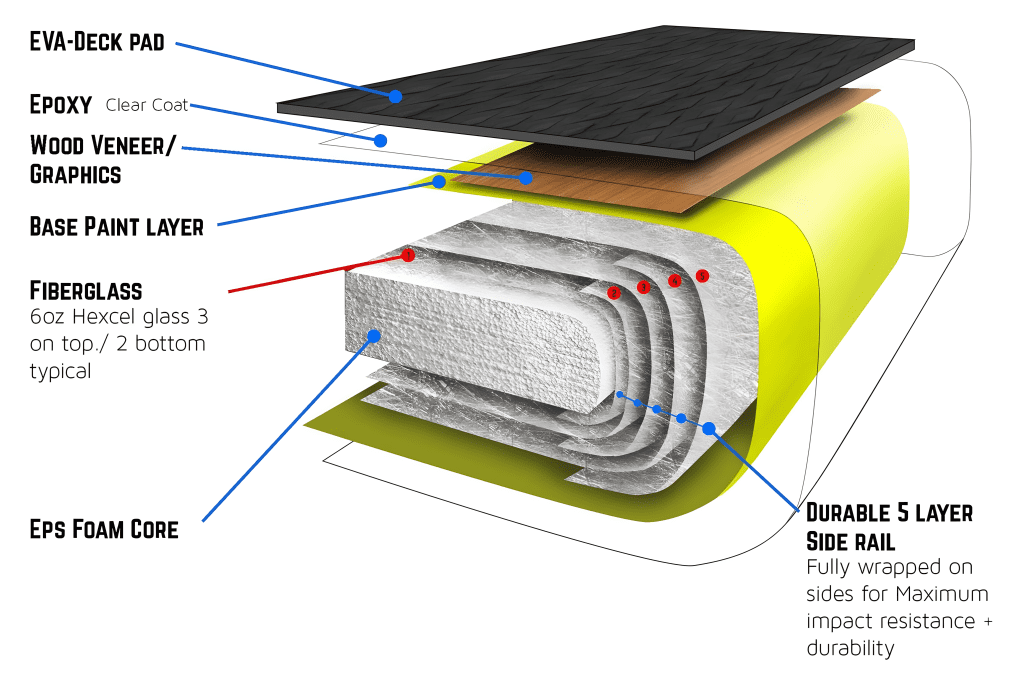
And when it comes to a fiberglass paddleboard, it has some key advantages when using it.
Key Advantages Of Fiberglass Paddleboards:
| Superior Performance: | Fiberglass paddleboards are known for their exceptional performance on the water. The rigid construction and streamlined shape allow for increased speed, maneuverability, and responsiveness, making them ideal for racing, surfing, and advanced paddleboarding techniques. |
| Stability: | Fiberglass paddleboards provide excellent stability, especially in rough waters. The rigid structure and lower center of gravity help maintain balance and control, giving riders the confidence to tackle challenging conditions. |
| Longevity: | With proper care and maintenance, fiberglass paddleboards can last for several years. They are resistant to wear and tear, making them a reliable option for frequent paddlers. |
So you can see why they are interesting for many people, especially when it comes to professional athletes and people that want to pull out of every drop of performance from their SUP.
Key Drawbacks Of Fiberglass Paddleboards:
| Weight and Portability: | Fiberglass paddleboards tend to be heavier compared to their inflatable counterparts. Transporting and storing these boards can be challenging, especially if you have limited space or need to travel frequently. |
| Fragility: | While fiberglass paddleboards are durable, they are more prone to dents, cracks, and damage from impact. This vulnerability requires careful handling, especially during transportation and storage. |
These are the main advantages and drawbacks of fiberglass paddleboards, and hopefully you have a good idea by now of whether you want one or not. But let’s talk about inflatable paddleboards.
| Want to see some recommendations? 5 Affordable Hard Paddle Boards For Thrifty Shoppers In 2024 |
Understanding An Inflatable Paddleboard
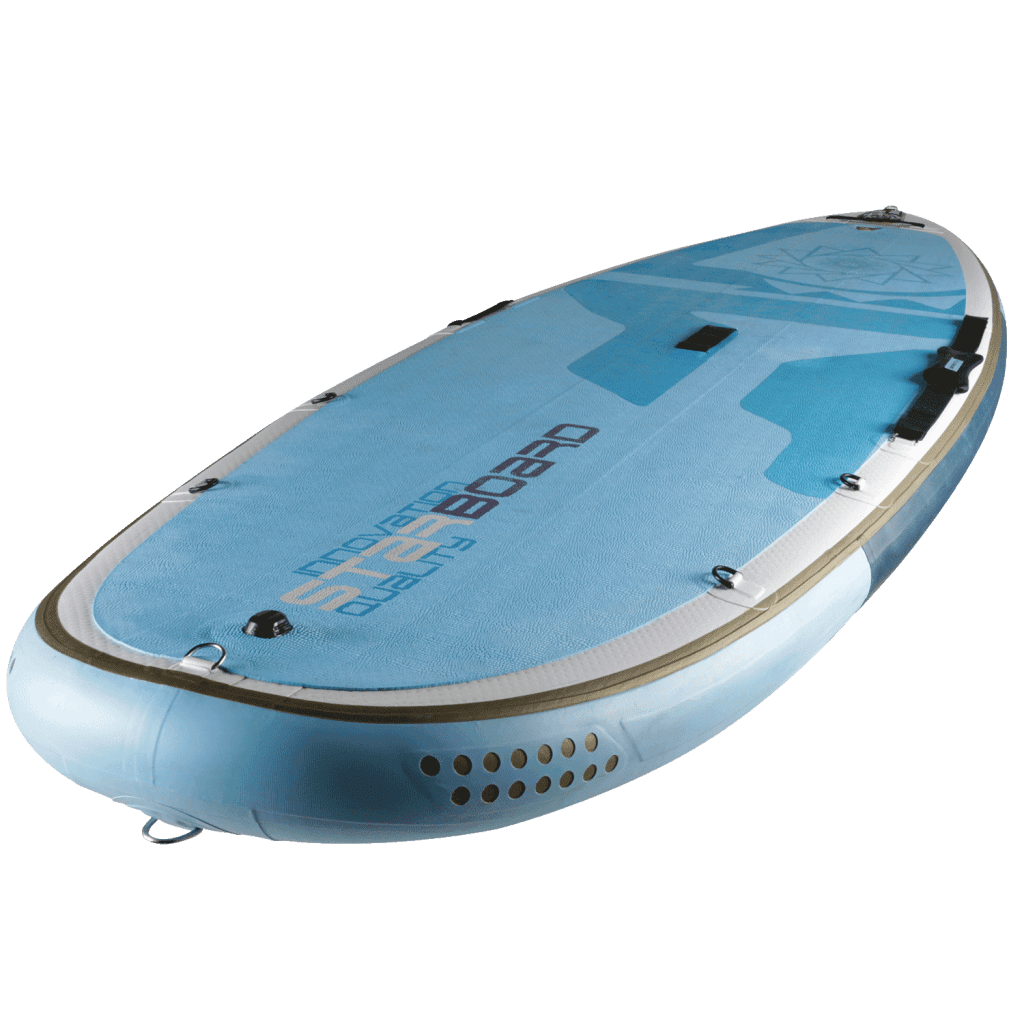
Inflatable paddleboards, on the other hand, are made from durable PVC or drop-stitch materials and can be inflated and deflated for easy transport and storage.
Their Construction:
The key difference between a fiberglass paddleboard and an inflatable one is the tube in the center that stores the air. Inflatable boards have this tube that contains nylon threads in the tube to improve the density of the board. This tube then is surrounded by 2 layers of base cloth and 2 layers of PVC. Then finally it is made airtight with railtape and a deckpad.
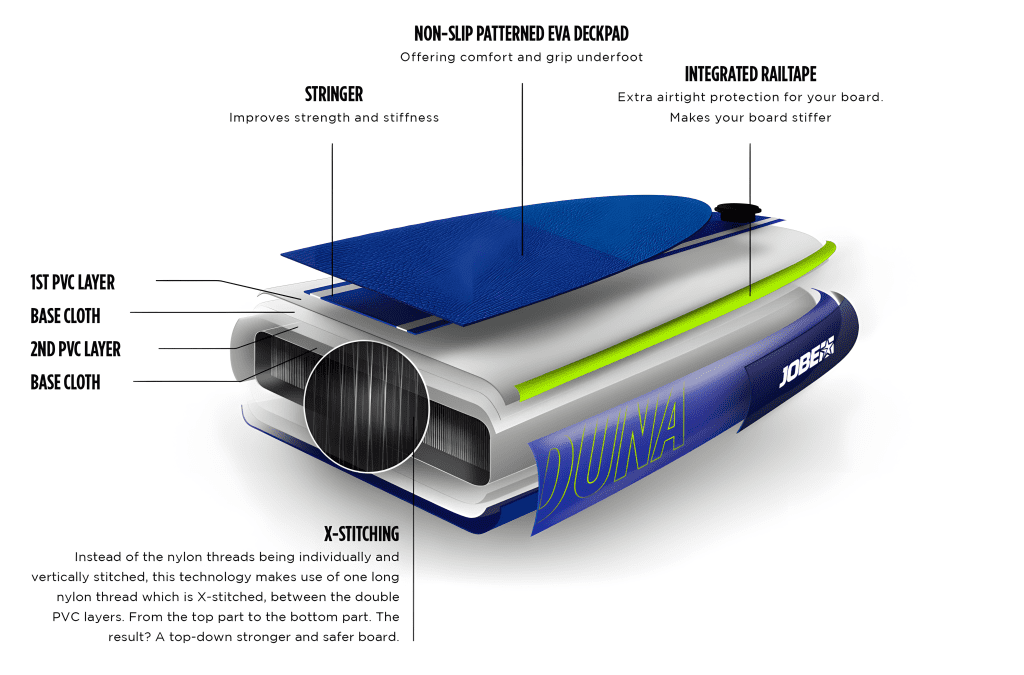
Key Advantages Of Inflatable Paddleboards:
| Portability: | One of the biggest advantages of inflatable paddleboards is their portability. When deflated, these boards can be rolled up and stored in a backpack or a compact carrying case. This makes them convenient for travelers, hikers, and those with limited storage space. |
| Versatility: | Inflatable paddleboards are versatile and can be used in various water conditions. They offer excellent stability and are suitable for beginners, recreational paddlers, and those who prefer a more relaxed paddling experience. |
| Durability: | While they may not be as durable as fiberglass paddleboards, modern inflatable paddleboards are designed to withstand impacts and rough handling. The use of high-quality materials and construction techniques ensures their longevity. |
In a nutshell – I view inflatable paddleboards as the best solution for beginners and people that want to SUP casually as opposed to looking for elite performance. They are easy to store, transport and use and that’s why they are a very attractive option for casual riders.
Key Drawbacks Of Inflatable Paddleboards:
| Performance: | Inflatable paddleboards generally offer slightly lower performance compared to fiberglass paddleboards. They are more affected by wind and water conditions, and their flexibility may result in slightly slower speeds and reduced maneuverability. |
| Inflation & Deflation: | While the process of inflating and deflating inflatable paddleboards is straightforward, it does require some time and effort. You need to have access to a pump and allocate a few minutes for setup and takedown. |
So those are the biggest problems that you’ll have to deal with when it comes to grabbing an inflatable paddleboard. Do you know which one you want yet?
If you’re still undecided then here are a few more consierations to help you.
Other Factors To Consider When Comparing A Fiberglass Paddleboard To An Inflatable One
To determine whether a fiberglass paddleboard or an inflatable paddleboard is the right choice for you, consider the following factors:
Usage and Portability:

If you plan to paddle mainly on calm lakes or rivers near your home and have ample storage space, a fiberglass paddleboard might be the better option. However, if you enjoy exploring different water bodies, traveling frequently, or require a portable solution, an inflatable paddleboard would be more suitable.
Stability and Performance:
If you prioritize high performance, speed, and responsiveness, a fiberglass paddleboard will deliver the best experience. On the other hand, if you value stability, versatility, and ease of use, an inflatable paddleboard will meet your needs.
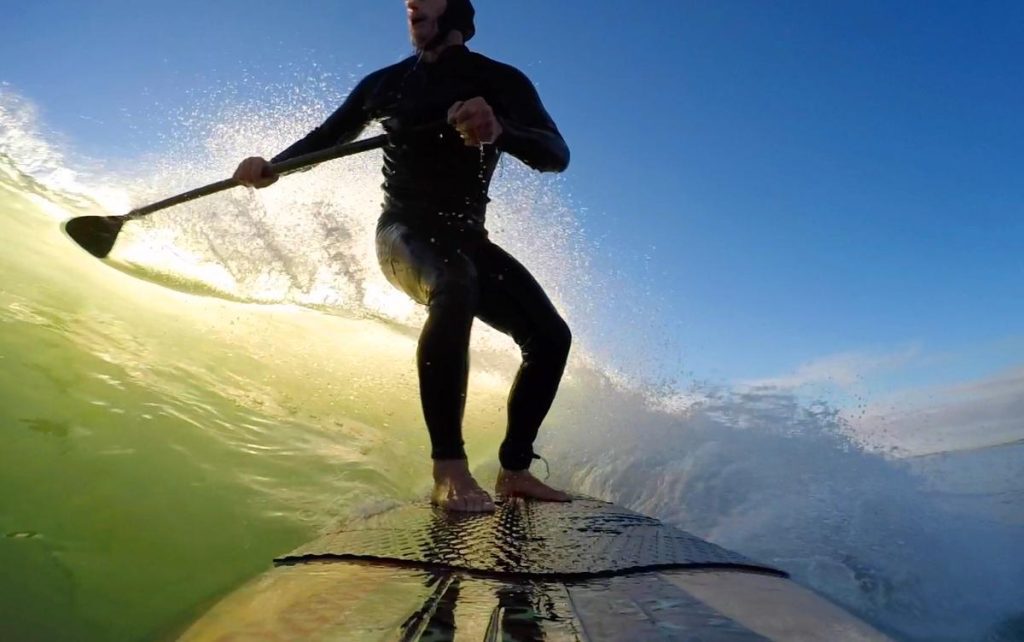
Durability and Maintenance:
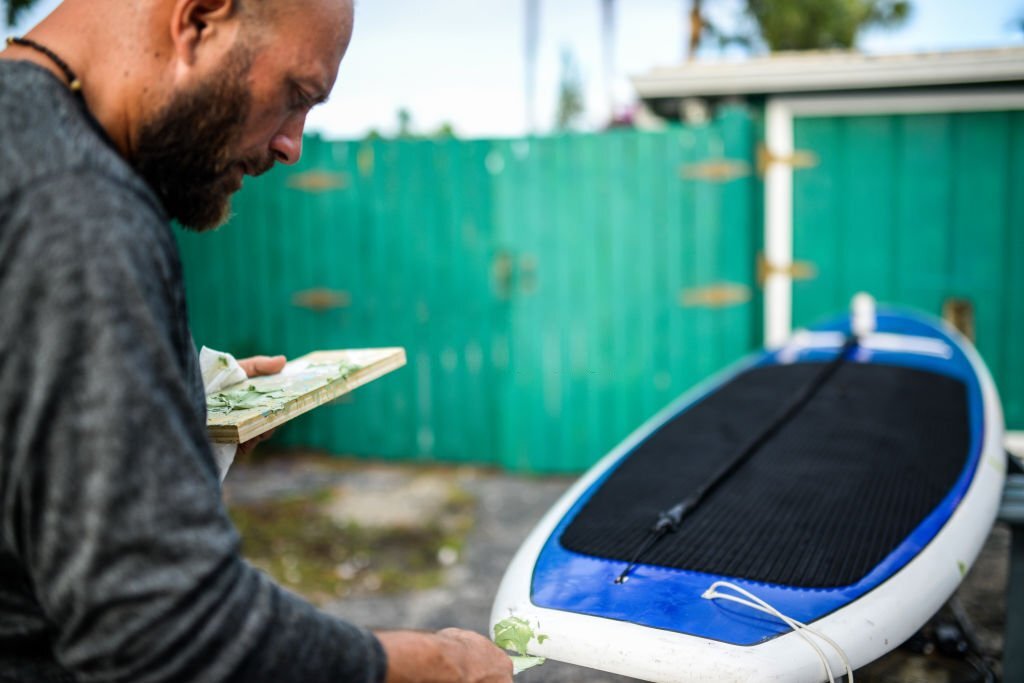
Fiberglass paddleboards require minimal maintenance but are more susceptible to damage from impact. Inflatable paddleboards are more forgiving in this regard, as their construction allows them to withstand bumps and scrapes more effectively.
Based on different scenarios, here are some recommendations:
Scenario 1: Casual Paddling and Occasional Travel:
If you primarily paddle for leisure, on calm waters, and occasionally travel to nearby destinations, an inflatable paddleboard is a great choice. Its portability, ease of setup, and versatility make it a convenient option for recreational paddlers.
Scenario 2: Performance-Oriented Paddling and Frequent Travel:
If you’re a seasoned paddler who values performance, participates in races, or frequently travels to different water bodies, a fiberglass paddleboard is the better option. Its superior speed, maneuverability, and stability will enhance your paddling experience.
Scenario 3: Family-Friendly and Versatile Paddleboarding:
If you plan to paddle with your family or friends, prefer a board that accommodates various skill levels, and need a durable option for a range of water conditions, an inflatable paddleboard is the ideal choice. Its stability, ease of use, and durability will cater to the needs of multiple riders.
My Favorite Inflatable SUPs Of 2024:
* Roc Inflatable SUP (Best Budget SUP OF 2024)

Where To Buy: Amazon
Why I Love It:
– Has a large non-slip comfort deck that can easily fit you and even an extra person
– Extremely high quality material that won’t get scuffed and damaged.
– 16.25 inch width makes it very stable
– It looks great!
* Portal 11’6″ Paddle Board (Best Overall SUP)
Where To Buy: Amazon
Why I Love It:
– 33 inch width gives it amazing width and stability.
– It has a depth of 6 inches that increases the weight capacity of the board to over 300lbs without sacrificing stability.
– This board has ample space along with a non-slip deck pad that is perfect for beginners
– It comes with everything included and a 2 year warranty.

* MYBOAT 11’6″Extra Wide SUP (Best Full Length Deck)

Where To Buy: Amazon
Why I Love It:
– This board is extra long and extra wide which is ideal for beginners (because it’s super stable)
– This board was designed for yoga so it’s super stable
– It comes with everything included and a 1 year warranty.
Conclusion
In the debate between fiberglass paddleboards and inflatable paddleboards, there is no definitive answer as to which one is better. It ultimately depends on your preferences, usage, and specific requirements. Fiberglass paddleboards offer superior performance but are heavier and less portable. Inflatable paddleboards excel in terms of portability, versatility, and family-friendly features but may sacrifice a bit of performance.
Consider your priorities, intended usage, and the factors mentioned above to make an informed decision. Remember, there is no right or wrong choice—it’s about finding the paddleboard that suits your needs and enhances your overall stand-up paddleboarding experience.
| Looking for insider guides to some amazing paddle boarding locations? Check the Paddleboard Insiders Location Guides |
FAQs
Are fiberglass paddleboards suitable for beginners?
Fiberglass paddleboards are more commonly used by experienced paddlers due to their performance-oriented nature. Beginners might find inflatable paddleboards more forgiving and easier to learn on.
Can inflatable paddleboards handle rough water conditions?
While inflatable paddleboards can handle some rough water conditions, they are generally better suited for calmer waters. Fiberglass paddleboards offer better stability and control in rougher conditions.
How long does it take to inflate an inflatable paddleboard?
The time required to inflate an inflatable paddleboard depends on the pump used and the size of the board. On average, it takes around 5-10 minutes to fully inflate an inflatable paddleboard.
Can fiberglass paddleboards be repaired if damaged?
Yes, fiberglass paddleboards can be repaired if they sustain damage. However, the repair process might require professional assistance, and it’s best to address any damages promptly to prevent further issues.
Can inflatable paddleboards deflate while on the water?
Inflatable paddleboards are designed to remain fully inflated while in use. However, minor air leakage can occur over time. It’s important to regularly check the inflation pressure and ensure proper valve closure before heading out on the water.
